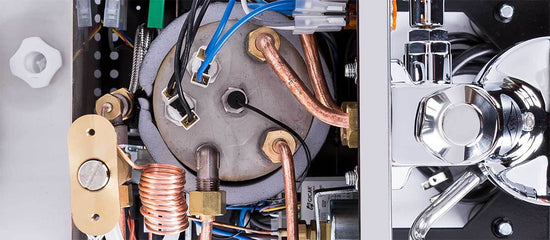How to Choose an Espresso Machine - Pumps and Water Supply

Espresso machines look cool, and they have a unique knack for making a deliciously concentrated brown liquid from roasted seeds. But what exactly is in that chrome box? They’re simpler than you might think, and only a few of the parts in there have a big impact on your experience when you’re using the machine.
In our first episode of this series, we covered boilers and PIDs, arguably the most important parts of an espresso machine. In this episode, we’ll be looking at the other key pieces of the puzzle: pumps and water supply methods.
Let’s start with pumps. In order to create espresso, you need pressure. Traditionally about 9 bars of pressure. To generate this pressure and move water into contact with our puck of grounds, we use a pump. There are two main types of pumps that cover almost all espresso machines: vibratory pumps and rotary pumps.
Vibratory pumps use a spring and piston design that, as the name suggests, vibrates to move water and create pressure. They have a bunch of benefits: they’re relatively cheap, very small, easily produce 9 bar pressure, and have a lifetime of around 5 years in most espresso machines. They don’t last forever, but they’re easy enough to replace yourself. The main drawback is that they produce a good bit of noise. That said, certain brands, like ECM and Profitec, do a great job of mounting their vibratory pumps making them relatively quiet. If you’re set on getting something that’s nearly silent you’ll want to the go with the next option: rotary pumps.
These use a large motor to rotate a gear-like mechanism which generates pressure. In addition to being very quiet, they can also last a lifetime. Rotary pumps are one of the most reliable parts of any espresso machine. They are also capable of operating with a reservoir or a direct water line, something vibratory pumps can’t do. The only drawbacks of rotary pumps are that they’re a good bit larger than vibratory pumps, and they cost quite a bit more.
This leads us to our second topic: water supply. You can’t make coffee without water. How it gets there is up to your preferences as well as your kitchen setup. If you have a water line that you’d like to hook up to your machine, you can look for a direct plumb machine. If not, an internal reservoir that you manually refill will do the trick.
You’ll find that many less expensive machines have vibratory pumps and run on a reservoir only. The key consideration with reservoir machines is access. Most of them will have access from the top at the back of the machine. If you plan to place your machine under a cabinet, you'll likely need to look for a machine with a front loading reservoir, like the LUCCA A53 Mini.
Alternatively, you can direct plumb your machine. We offer a filtration and softening kit that takes care of everything between your water outlet and the machine, so setup is quite simple. For many, not having to refill a reservoir can be a huge perk, particularly if you aim to pull plenty of shots. The other perk is true pre-infusion, which uses line pressure to saturate the puck before applying full pressure. Most direct plumb machines also have an internal reservoir and can be easily switched between the two.
Once you’ve figured out what boiler arrangement, pump, and water supply you want you should be down to just one or two espresso machines. From there it’s all about what gets you the most excited to begin your career as a home barista.